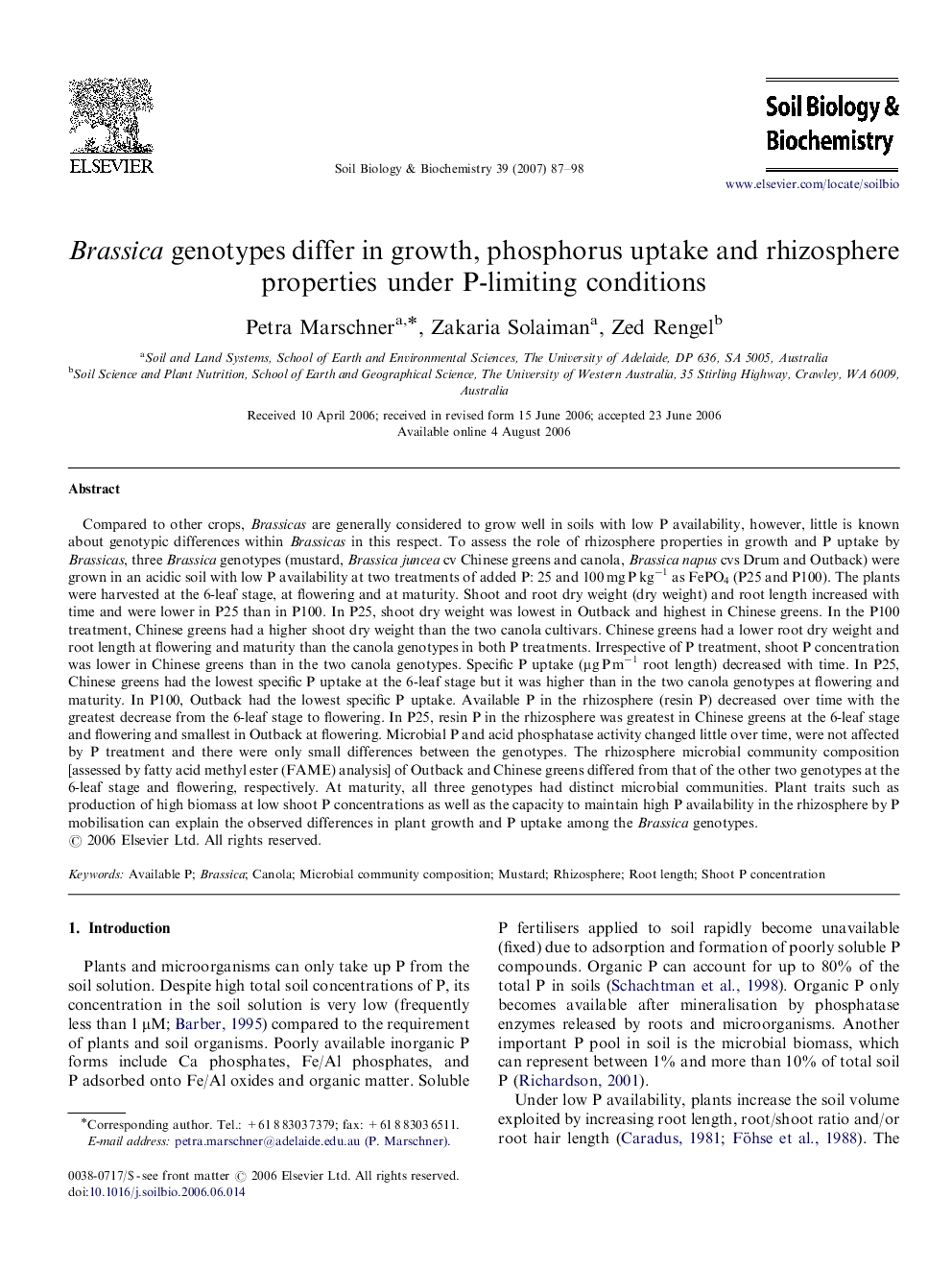| کد مقاله | کد نشریه | سال انتشار | مقاله انگلیسی | نسخه تمام متن |
|---|---|---|---|---|
| 2025868 | 1070012 | 2007 | 12 صفحه PDF | دانلود رایگان |
عنوان انگلیسی مقاله ISI
Brassica genotypes differ in growth, phosphorus uptake and rhizosphere properties under P-limiting conditions
دانلود مقاله + سفارش ترجمه
دانلود مقاله ISI انگلیسی
رایگان برای ایرانیان
کلمات کلیدی
موضوعات مرتبط
علوم زیستی و بیوفناوری
علوم کشاورزی و بیولوژیک
دانش خاک شناسی
پیش نمایش صفحه اول مقاله

چکیده انگلیسی
Compared to other crops, Brassicas are generally considered to grow well in soils with low P availability, however, little is known about genotypic differences within Brassicas in this respect. To assess the role of rhizosphere properties in growth and P uptake by Brassicas, three Brassica genotypes (mustard, Brassica juncea cv Chinese greens and canola, Brassica napus cvs Drum and Outback) were grown in an acidic soil with low P availability at two treatments of added P: 25 and 100 mg P kgâ1 as FePO4 (P25 and P100). The plants were harvested at the 6-leaf stage, at flowering and at maturity. Shoot and root dry weight (dry weight) and root length increased with time and were lower in P25 than in P100. In P25, shoot dry weight was lowest in Outback and highest in Chinese greens. In the P100 treatment, Chinese greens had a higher shoot dry weight than the two canola cultivars. Chinese greens had a lower root dry weight and root length at flowering and maturity than the canola genotypes in both P treatments. Irrespective of P treatment, shoot P concentration was lower in Chinese greens than in the two canola genotypes. Specific P uptake (μg P mâ1 root length) decreased with time. In P25, Chinese greens had the lowest specific P uptake at the 6-leaf stage but it was higher than in the two canola genotypes at flowering and maturity. In P100, Outback had the lowest specific P uptake. Available P in the rhizosphere (resin P) decreased over time with the greatest decrease from the 6-leaf stage to flowering. In P25, resin P in the rhizosphere was greatest in Chinese greens at the 6-leaf stage and flowering and smallest in Outback at flowering. Microbial P and acid phosphatase activity changed little over time, were not affected by P treatment and there were only small differences between the genotypes. The rhizosphere microbial community composition [assessed by fatty acid methyl ester (FAME) analysis] of Outback and Chinese greens differed from that of the other two genotypes at the 6-leaf stage and flowering, respectively. At maturity, all three genotypes had distinct microbial communities. Plant traits such as production of high biomass at low shoot P concentrations as well as the capacity to maintain high P availability in the rhizosphere by P mobilisation can explain the observed differences in plant growth and P uptake among the Brassica genotypes.
ناشر
Database: Elsevier - ScienceDirect (ساینس دایرکت)
Journal: Soil Biology and Biochemistry - Volume 39, Issue 1, January 2007, Pages 87-98
Journal: Soil Biology and Biochemistry - Volume 39, Issue 1, January 2007, Pages 87-98
نویسندگان
Petra Marschner, Zakaria Solaiman, Zed Rengel,